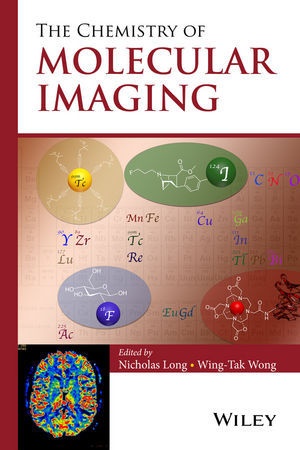Read more
"This book investigates the chemistry of molecular imaging and helps to educate non-chemists already involved in the area of molecular imaging. It addresses all the major modalities and techniques, such as MRI, positron emission tomography, single photonemission computed tomography, ultrasound, and fluorescence/optical imaging"--
List of contents
Preface ix
List of Contributors xi
1 An Introduction to Molecular Imaging 1
Ga-Lai Law and Wing-Tak Wong
1.1 Introduction 1
1.2 What is Positron Emission Tomography (PET)? 3
1.3 What is Single Photon Emission Computed Tomography (SPECT)? 6
1.4 What is Computed Tomography (CT) or Computed Axial Tomography (CAT)? 8
1.5 What is Magnetic Resonance Imaging (MRI)? 11
1.6 What is Optical Imaging? 15
1.7 What is Ultrasound (US)? 19
1.8 Conclusions 22
References 24
2 Chemical Methodology for Labelling and Bioconjugation 25
Lina Cui and Jianghong Rao
2.1 Introduction 25
2.2 Chemical Methods 25
2.3 Site-Specific Modification of Proteins or Peptides 36
2.4 Conclusions 45
References 45
3 Recent Developments in the Chemistry of [18F]Fluoride for PET 55
Dirk Roeda and Frédéric Dollé
3.1 Introduction 55
3.2 Fluorine-18: The Starting Material 56
3.3 Reactive [18F]Fluoride 56
3.4 The Radiofluorination 58
3.5 Labelling of Large Biological Molecules 65
3.6 Conclusions 70
References 70
4 Carbon-11 Nitrogen-13 and Oxygen-15 Chemistry: An Introduction to Chemistry with Short-Lived Radioisotopes 79
Philip W. Miller Koichi Kato and Bengt Långström
4.1 Introduction 79
4.2 Carbon-11 Chemistry 81
4.3 Nitrogen-13 Chemistry 93
4.4 Oxygen-15 Chemistry 98
4.5 Conclusions 99
References 99
5 The Chemistry of Inorganic Nuclides (86Y 68Ga 64Cu 89Zr 124I) 105
Eric W. Price and Chris Orvig
5.1 Introduction: Inorganic Nuclide-Based Radiopharmaceuticals 105
5.2 Radiopharmaceutical Design 107
5.3 Radiopharmaceutical Stability 108
5.4 86Yttrium Radiometal Ion Properties 110
5.5 68Gallium Radiometal Ion Properties 116
5.6 64Copper Radiometal Ion Properties 120
5.7 89Zirconium Radiometal Ion Properties 123
5.8 124Iodine Nuclide Properties 125
5.9 Conclusions 129
References 129
6 The Radiopharmaceutical Chemistry of Technetium and Rhenium 137
Jonathan R. Dilworth and Sofia I. Pascu
6.1 Introduction 137
6.2 Technetium and Rhenium Radiopharmaceutical Chemistry 139
6.3 Technetium and Rhenium(IV) 149
6.4 Technetium and Rhenium(III) 149
6.5 Technetium and Rhenium(I) 151
6.6 Imaging of Hypoxia with 99mTc 155
6.7 Technetium and Rhenium Diphosphonate Complexes 157
6.8 The Future for Technetium and Rhenium Radiopharmaceuticals 157
References 158
7 The Radiopharmaceutical Chemistry of Gallium(III) and Indium(III) for SPECT Imaging 165
Jonathan R. Dilworth and Sofia I. Pascu
7.1 Introduction to Gallium and Indium Chemistry 165
7.2 Gallium and Indium Complexes and Related Bioconjugates 166
7.3 Auger Electron Therapy with 111Indium 175
7.4 Prospects for 67Ga and 111In Radiochemistry 176
References 176
8 The Chemistry of Lanthanide MRI Contrast Agents 179
Stephen Faulkner and Octavia A. Blackburn
8.1 Introduction 179
8.2 Gadolinium Complexes as MRI Contrast Agents 180
8.3 Minimising the Toxicity of Gadolinium Contrast Agents 184
8.4 Rationalising the Behaviour of MRI Contrast Agents 185
8.5 Strategies for Increasing Relaxivity 188
8.6 Responsive MRI 192
8.7 Conclusions and Prospects 195
References 195
9 Nanoparticulate MRI Contrast Agents 199
Juan Gallo and Nicholas J. Long
&
Summary
Molecular imaging is primarily about the chemistry of novel biological probes, yet the vast majority of practitioners are not chemists or biochemists. This is the first book, written from a chemist's point of view, to address the nature of the chemical interaction between probe and environment to help elucidate biochemical detail instead of bulk anatomy.
* Covers all of the fundamentals of modern imaging methodologies, including their techniques and application within medicine and industry
* Focuses primarily on the chemistry of probes and imaging agents, and chemical methodology for labelling and bioconjugation
* First book to investigate the chemistry of molecular imaging
* Aimed at students as well as researchers involved in the area of molecular imaging

